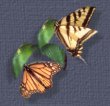|
Bigger is better! It would be best
to get the tallest cage possible, at least 3 feet. An aquarium is not a suitable
cage. A lot of the sugar glider cages I have seen for sale are way too small. It
is VERY cruel to keep a glider in a small cage. Bare wire cages can irritate
glider feet and it can get really noisy when they climb on it. It is best to get
or make a vinyl or powder coated wire cage. Not only does this minimize risk of
irritation and is a lot quieter, it is also much easier to clean and will not
rust. I have heard that galvanized wire might cause heavy metal poisoning, but I
have also heard of people having no problems at all. In order for this to
happen, your glider has to continually chew on the wire and injest it. Just to
be safe, don't use bare galvanized wire. There are plexi-glass cages available
for sugar gliders, but these can scratch easily and you have to provide lots
more climbing branches. If you are going to buy a cage make sure the hole
spacing is not any bigger than 1/2" x 1", smaller if you are planning to breed
them. You may want to consider buying a bird cage, however it can be really
expensive to buy a cage tall enough. If you don't have a big budget, I would
suggest making a cage. It is not hard to make a cage even if you don't have much
experience, tools, or space. I built my cage in the kitchen of my apartment. If
you can't find vinyl coated wire, it may be better to buy your cage.

Stuff to Put Inside
Your Cage
1. Nestbox or pouch. Gliders need a secure place to sleep. A nestbox is best if
you have several gliders or are breeding them. If you get a nestbox, make sure
that it is not bare wood as the glider's pee will soak into it and have to be
replaced often. It would be best to get a plastic or plexi-glass box. In the
bottom you should put some kind of liner such as aspen bedding, tissues or a
piece of fleece. However if you have less than four gliders, I recommend getting
a pouch instead. You can take their pouch out of the cage and dump them directly
into your bonding pouch without disturbing them too much. This can make the
bonding process a lot easier on the both of you. You should have more than one
to make sure they have a clean one. I have both a pouch and a nestbox in my cage
and they alternate between them.

2. Non-toxic branches
and perches. Some good non-toxic branches are eucalyptus and manzanita. These
can be usually be found:Exotics Central sells a manzanita perch with toy or look
in bird specialty stores or websites. You also could use live tree branches but
make sure they are nontoxic and have not been sprayed with pesticides. House
plants (even non-toxic ones) inside your gliders cage is not a good idea though.
You can have trees or plants for them to play on outside of their cages,
provided you supervise them carefully to make sure they are not eating any. A
lot of glider owners have hibiscus or eucalyptus trees for playing in. If you
are worried about which plants might be toxic, take a look at these sites:
Edible & Harmful Plants and Toxic, Harmful & Safe Plants & Foods.

3. Food dishes and
water bottle. Large bird seed cups work well as they attach to the side. Get
ceramic or stainless steel dishes if possible, plastic dishes scratch easily and
can harbor harmful bacteria. Gliders won't usually eat food too close to the
ground. Also, if they are placed high in the cage, it is less likely poop will
fall in their food. Water bottles shouldn't be too big, the water needs to be
changed often. Bird water bottles are a good choice.

4. Toys. Bird toys such
as swings, rings, ladders, and mirrors help to entertain gliders. Just be
careful not to get any with loose strings or fabric they might injest. Be sure
to rotate toys to keep gliders from losing interest. A wheel can provide
additional entertainment and exercise. However, an exercise wheel should not
have cross bars or spaces where fragile tails can get caught, so regular hamster
wheels are not a good idea. A lot of glider owners and breeders highly recommend
the Wodent Wheel as a safe choice.

5. Bedding. You will
probably want to put some type of bedding on the floor of the cage. Do Not use
newspaper, cedar, or pine, these are toxic to small animals. Instead, use aspen
shavings, oat hull, or corncob bedding.

6. Plastic or metal
tray. The Pet Butler Co. makes two kinds of trays. One you put under your cage
(Mess Catcher) and the other is a sliding litter tray replacement (The Critter
Tray.) They come in fairly large sizes

How should I clean my
cage? Every week or so, you will need to clean your cage. If you have a male, be
careful not to clean too often. If you are constantly cleaning their cage this
will often result in the males scent marking more. I have found that a mixture
of baking soda and water sprayed on the cage and rinsed off helps control odor
best.

|